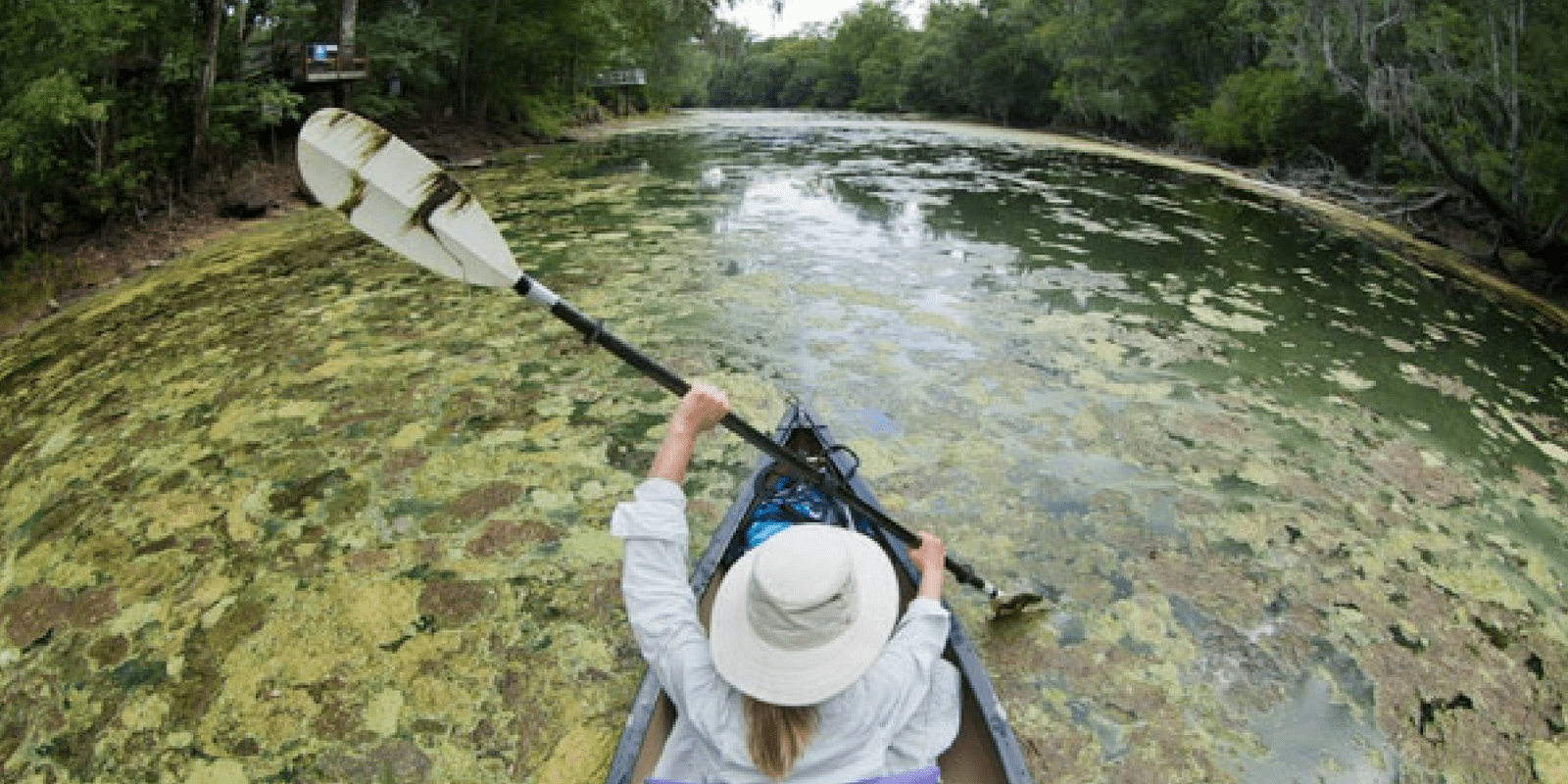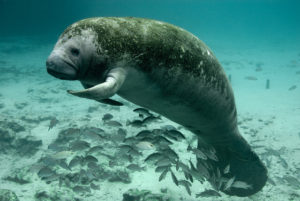We have much more to do and your continued support is needed now more than ever.
As Florida Algae Crisis Hits Wildlife, NWF Works to Strengthen Water Protections

Florida’s coastal communities and wildlife are getting hammered this summer by a double whammy of red tide and blue-green algae. Natural factors and manmade problems are combining like a hurricane hitting at high tide to deliver a surge of setbacks for many already-struggling fish, marine mammals and other water-dependent creatures.
The communities being hit are busy trying to save wildlife, clean waterways and beaches, and working to help coastal businesses manage during summer season. But it’s worth looking at the causes of the crisis to see what policy lessons we can learn.
The Algae Crisis & Its Impacts
There are two separate kinds of toxic algae outbreaks hitting Florida from two different directions:
- Red tide algae forming along Florida’s southern Gulf coast. Red tide is a microscopic organism known as dinoflagellate, which produces harmful effects on public health and marine resources.
- Blue-green algae being discharged from Lake Okeechobee into the St. Lucie River to the Atlantic coast and the Caloosahatchee River to the Gulf coast.
While algae is natural, it’s fueled by runoff pollution and warmer water. From the Gulf Coast to the Great Lakes, global warming is making algae blooms worse.
The red tide algae has proved especially deadly for fish and wildlife, as the Miami Herald’s Jenny Staletovich reports:
Dead fish by the thousands have clogged inlets and canals. Since Sunday, 10 dead Goliath grouper, the massive reef fish that can live four decades or more, have floated to the surface. At least 90 sea turtles have been found stranded as the tide stretches well into nesting season. And Tuesday, as hundreds of residents packed a standing-room-only Cape Coral yacht club to hear about the federal government’s efforts to deal with water conditions, a dead manatee washed up at a nearby boat ramp.
The list goes on: earlier this month the carcass of a whale shark was found on a Sanibel beach with red tide in its muscles, liver, intestines and stomach. Hundreds of double-breasted cormorants, brown pelicans and other seabirds have been sickened or died.
The algae is also sickening people. At least 15 people have been treated and released at local hospitals, but doctors suspect a much larger number of people are feeling mild nausea from the algae without seeking medical attention. Dogs who swim in algae can be at risk of illness or even death, but it seems like Florida dog owners have kept their pets safe so far.
“Florida’s algae crisis is a case study of what we’re seeing play out across the country, as water pollution and worsening climate disruption degrade important fish and wildlife habitat, turning what might’ve once been just a bad summer into a prolonged disaster,” said Collin O’Mara, president and CEO of the National Wildlife Federation. “If we want to reverse America’s rising tide of wildlife crisis, Congress needs to face the problem on every front by enacting common-sense clean water protections, passing a Water Resources Development Act that commits to Everglades restoration and water infrastructure, and investing in proactive, collaborative conservation through the Recovering America’s Wildlife Act.”
Water Policy Must Rise to Meet Challenge
Water in Florida historically flowed south, through Lake Okeechobee to the Everglades and Florida Bay. To pave the way for development and agriculture, humans altered this natural flow of water by digging canals and building dams, diverting more water to the east and west coasts through the St. Lucie and Caloosahatchee Rivers. This re-plumbing upset the natural flow of life-giving water through the Everglades that sustains South Florida’s unique wildlife habitat and heralded fishing grounds.

“Too little freshwater is flowing through the Everglades to Florida Bay, while too much polluted water is flushed from Lake Okeechobee to coastal estuaries, causing outbreaks of toxic green algae to slime Florida’s beaches,” wrote NWF’s Glenn Watkins last year, detailing the harm it was having on Florida’s fish and the anglers who depend on them.
I asked Manley Fuller, president of our state affiliate the Florida Wildlife Federation, to explain some of the policy choices that have led us here:
The current nightmare is largely due to the way the Everglades is engineered and needs to be corrected through moving forward expeditiously with key facets of Everglades restoration including increased water storage capacity, treatment and conveyance of clean water south from the Lake Okeechobee. This will reduce the frequency of destructive estuarine discharges. In the short term, the high water discharges from Lake Okeechobee should be pulsed to the greatest extent possible rather than continuous outflow. The Everglades Agricultural Area water storage capacity should be increased to share in the adversity along with natural areas. Sugar cane can tolerate short term inundation. During these high water circumstances, adversity must be shared.

This week Florida Gov. Rick Scott has announced funds to help fix the Herbert Hoover Dike surrounding Lake Okeechobee, as well as money for Lee County to combat the algae directly. Rep. Brian Mast also introduced a bill designed to free up more federal funds to help fight algae.
However, fixing this problem requires restoring the Everglades by changing the way that water moves through the system to mimic the historic flow. Congress must approve construction of a critical reservoir south of Lake Okeechobee – part of the Central Everglades Project – in the water resources bill that is awaiting floor time in the Senate. This project will significantly alleviate the damaging discharges to the fragile coastal estuaries, instead cleaning and sending that water south to the Everglades and Florida Bay where it is desperately needed.
We’ll continue monitoring the harm the algae is doing – and the National Wildlife Federation will keep working to deliver the policy necessary to protect Florida’s outdoor treasures for future generations.






















